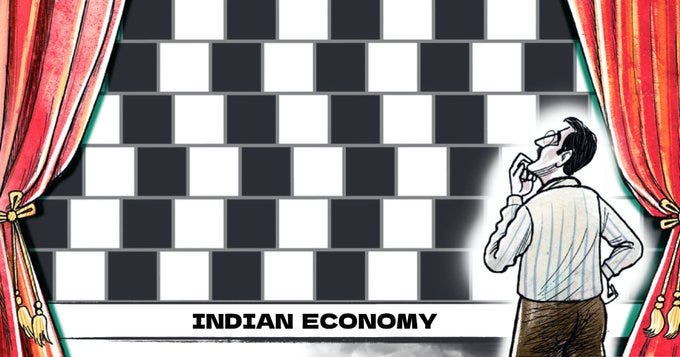India’s Election In The Last Leg, What Are Investors Expectations Even As India Economy Grew At Weakest Pace, Jan-March 24

As India’s marathon national election—the largest in the world—nears its conclusion, with the vote count slated for June 4, investors are bracing themselves for what seems like Prime Minister Narendra Modi’s anticipated third term.
However, speculation suggests the victory margin might be narrower than previously thought, according to analysts and informal betting markets.
Analysts are now playing out likely scenarios in the election aftermath; they believe the outcome will significantly impact market dynamics.
) Market Reactions In Focus
Market Reactions In Focus
Despite Indian equities exhibiting strong performance in 2023 and currently maintaining high valuations, there’s potential for a short-term surge if Modi secures an unprecedented third consecutive term.
Such an outcome would likely signal policy continuity and political stability, thereby buoying investor sentiment.
Notably, the BSE Sensex Index has already notched a 4% uptick this year, with equity analysts foreseeing further gains by year-end, potentially doubling the current figures.
The prospect of a narrower victory margin for Modi could introduce short-term market volatility, while an opposition win might trigger a more pronounced correction owing to resultant policy uncertainties.
Mittul Kalawadia, a senior equity fund manager at ICICI Prudential Mutual Fund in Mumbai, emphasized the market’s inclination towards Modi’s continuity. Any deviation from this expectation, such as a coalition government or another party emerging victorious, could provoke a swift market response, Kalawadia noted, cautioning against potential knee-jerk reactions in such scenarios.
 Continuity In Policy
Continuity In Policy
A potential third term for a Modi-led government promises continuity of policies, with a focus on strengthening fiscal management and maintaining currency stability.
Ashish Gupta, Chief Investment Officer at Mumbai-based Axis Mutual Fund, emphasises India’s recent stability in current account deficits, fiscal discipline, and inflation control.
He anticipates this emphasis on macroeconomic stability to persist, which has largely contributed to a reduction in India’s risk premium across debt and equity markets.
At the same time, Modi’s proactive approach to attracting foreign investment, illustrated by efforts to lure tech giants like Apple and Tesla to establish operations in India, is expected to continue.
Vivek Bhutoria, Co-Portfolio Manager at Federated Hermes’ global emerging markets equity fund in London, suggests that a decisive electoral mandate and a business-friendly government would likely sustain foreign capital inflows.
) Tax Stability
Tax Stability
Amidst the election campaign, India’s main opposition party, the Congress, has hinted at policies targeting income inequality; however, investors remain cautious, wary of an overemphasis on welfare schemes.
Gary Tan, Portfolio Manager at Allspring Global Investments in Singapore, expresses concern over the potential strain on public finances and macro stability if the ruling BJP too leans too heavily on such schemes.
Reports circulating in local media have hinted at possible changes to capital gains tax, a prospect that the current administration has refused.
Nilesh Shah, CEO of Kotak Mahindra Asset Management, does not foresee such a move, instead anticipating policies aimed at deepening India’s capital markets.
Sectors Under The Lens
Under the current government’s emphasis on infrastructure spending and manufacturing promotion, fund managers are gravitating towards sectors set to benefit from these policies.
Power, automotive, and infrastructure sectors are particularly drawing investor optimism. Sanjay Bembalkar, Co-Head of Equities at Mumbai-based Union Asset Management Company, spotlights a positive outlook for companies positioned to capitalize on India’s manufacturing drive, such as capital goods firms, automotive manufacturers, and metal producers.
 India’s Weakest Economic Growth Projection
India’s Weakest Economic Growth Projection
Meanwhile, given all the positive outlook, India’s economy is projected to have expanded at its slowest pace in a year during the January-March quarter, primarily due to sluggish demand, as indicated by a Reuters poll of economists.
Despite a surprising 8.4% GDP growth in the October-December period, propelled by a substantial reduction in subsidies artificially boosting net indirect taxes, the gross value added (GVA) metric demonstrated a more modest 6.5% expansion.
Economists in the survey doubt the replication of this scenario in the last quarter, predicting a slowdown and forecasts suggest a growth rate of around 6.7% annually for the January-March period, aligning more closely with the economy’s long-term GDP growth trajectory.
At the same time, GVA growth is anticipated to decelerate to 6.2%.
The consensus among economists is due to the anticipated slowdown to waning momentum in both manufacturing and services sectors, along with subdued agricultural contributions.
) GDP Growth Forecasts and Expectations
GDP Growth Forecasts and Expectations
Projections for GDP growth span a range of 5.6% to 8.0%, with data slated for release at 1200 GMT on May 31, just days ahead of the announcement of general election results on June 4, even as Prime Minister Narendra Modi is anticipated to clinch a rare third term in office.
“We expect some sanity to return,” remarks Kunal Kundu, India economist at Societe Generale. Kundu anticipates no significant improvements among the GDP components.
However, a substantial majority of economists, over two-thirds, express scepticism regarding the likelihood of GDP growth surpassing their forecasts.
“Core inflation’s continuous decline and its lowest growth since the pandemic’s onset indicate weak domestic demand,” observes Kundu.
Also anticipated is weaker growth in private consumption, which constitutes 60% of GDP, which is expected to manifest in forthcoming quarters.
Economic growth, which averaged 7.7% in the last fiscal year, is forecast to decelerate to 6.8% in the current fiscal year and further to 6.6% in the subsequent one.
This suggests that consistent 8% growth, characteristic of the world’s fastest-growing major economy, remains distant.
While many economists argue that 8% or higher growth is imperative for generating sufficient job opportunities for the growing youth workforce, some doubt the feasibility of maintaining such growth rates.
Miguel Chanco, Chief Emerging Asia Economist at Pantheon Macroeconomics, deems 5-6% a “reasonable” potential growth rate for India. However, he emphasizes that achieving this potential necessitates sustained reforms and expresses concern over recent setbacks in this regard.
Additionally, a growing disparity between financial economists’ GDP forecasts and government estimates has prompted scrutiny over India’s growth measurement methodologies.
The National Statistical Office (NSO) forecasts 5.9% GDP growth in the January-March quarter, while Dhiraj Nim, an Economist at ANZ, suggests a potential overestimation of the informal sector’s GDP contribution, pointing out that ground realities may not align with headline figures.
Moreover, it is essential for the informal sector, which contributes nearly half of the country’s GDP and employs approximately 90% of India’s workforce, to indicate the significance of accurately gauging economic performance.




